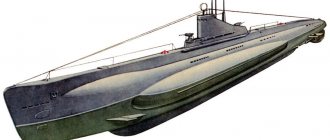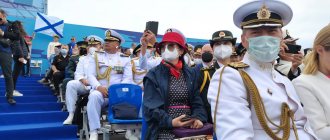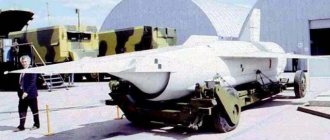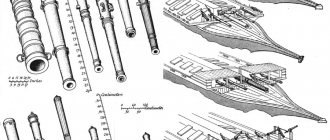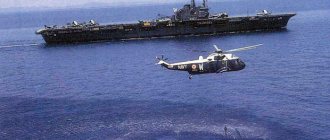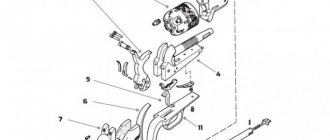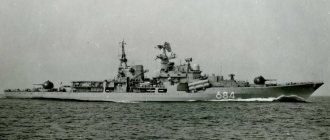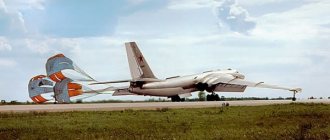Aircraft-carrying submarines of the Sentoku type (Japan)
Last December, scientists at the University of Hawaii (USA) reported an interesting discovery. At the end of summer, while conducting research on the seabed, Hawaiian scientists discovered the Japanese submarine of the Sen Toku project, which was sunk in 1945 (sometimes the index of the lead submarine is used to designate the project - I-400). The submarine lies at a depth of about 700 meters near the island of Oahu. The fact that a Japanese submarine sank after the end of World War II was no secret, but the exact place where it happened remained unknown for a number of reasons. During World War II, a large number of submarines of various types served in the Japanese navy. However, the most interesting are the submarines of the Sentoku project, which differed from others in their purpose.
Since the early thirties, Japanese shipbuilders have been creating submarines capable of carrying light aircraft. It was assumed that the aircraft transported by the boat would perform reconnaissance functions. In the future, the strike role of the aircraft was not excluded, however, a number of features of aircraft-carrying submarines and aircraft for them imposed certain restrictions on the combat load. However, reconnaissance aircraft were also quite useful for submarines. In particular, after the attack on Pearl Harbor, photo and filming of the results of the raid was carried out by a reconnaissance aircraft delivered to the Hawaiian shores by the I-9 Project A1 submarine.
At the beginning of 1942, on the initiative of Admiral I. Yamamoto, the creation of a project for a new submarine capable of carrying several bomber aircraft began. At the same time, the development of a specialized seaplane, suitable for transportation on a promising submarine and capable of carrying bomb weapons, began. It was assumed that the new submarines would be able to secretly deliver attack aircraft to coastal targets or enemy ship groups. The stealthy approach and surprise attack were expected to ensure high combat effectiveness of the new submarines and their aircraft. High demands were placed on the promising submarine. It was supposed to carry four aircraft and have a cruising range of 65-70 thousand kilometers. The underwater range had to exceed 100 km. The result of such requirements was the dimensions and displacement of the promising submarine. The underwater displacement, according to calculations, should have exceeded 6.5 thousand tons.
The specific purpose of the promising submarine determined its architecture. It was proposed to make the Sentoku submarines double-hulled, with a durable hull of complex shape. To transport a sufficient amount of fuel, as well as to accommodate an acceptable sealed hangar, it was necessary to develop an original durable body of variable cross-section. In the bow it consisted of two large “pipes” and in cross-section resembled a figure eight. Towards the middle part, the shape of the durable body gradually changed and became like an infinity sign. This was due to the placement of a cylindrical hangar. The aft part of the durable hull was made in the shape of the number 8 and also smoothly mated with the central one. It was proposed to cover the durable body with a streamlined lightweight.
A cylindrical (about 3.5 meters in diameter) hangar for transporting aircraft was placed above the middle part of the hull, similar to the “∞” sign. The Sentoku project submarines were supposed to carry three Aichi M6A Seiran seaplanes with a supply of fuel and weapons. The large dimensions of the submarine made it possible to simplify the take-off procedure to some extent. After surfacing, the submariners had to open the front hatch of the hangar, roll the plane onto the deck and prepare it for takeoff. Next, the M6A seaplane had to be mounted on a catapult to ensure takeoff. It was proposed to land, as before, on water, followed by lifting the aircraft on board using a crane.
The most noticeable consequence of the high demands placed on the Sentoku project was the large dimensions of the submarine. With an underwater displacement of 6,560 tons (surface - no more than 5,200 tons), the new submarines were to have a total length of 122 meters and a maximum hull width of 12 m. The average draft was 7 meters. Thus, Japanese submarines of the I-400 series became the largest representatives of their class during the Second World War. Moreover, their record for size and displacement lasted until the advent of nuclear submarines. Another record for the largest Japanese submarines concerned cruising range. The calculated value of this parameter exceeded 69 thousand kilometers. This meant that the Sentoku project boat would be able to reach anywhere on the planet without needing to refuel.
To propel such a large submarine, it was necessary to create a power plant of appropriate power. On the surface, the Sentoku submarines were supposed to move with the help of four diesel engines with a power of 2250 hp each. every. To move underwater, the boats were supposed to be equipped with two electric motors with a power of 2100 hp each. With such a power plant, promising aircraft-carrying submarines could reach a speed of at least 18 knots on the surface, and about 12 knots while submerged. The characteristics of the durable hull and hangar allowed it to dive to a depth of 100 meters.
The crew of the Sentoku project submarines, according to various sources, consisted of 144 people (21 officers) or more. The supply of food and fresh water was designed for a voyage lasting up to 90 days.
Like other submarines of that time, the Sentoku was proposed to be equipped with torpedoes and artillery weapons. Eight 533 mm torpedo tubes were installed in the bow compartment of the submarines. The carried ammunition consisted of 20 torpedoes. In addition, the submarines had to carry powerful anti-aircraft weapons. It consisted of three three-barreled artillery mounts based on the Type 96 automatic cannon of 25 mm caliber, as well as one such cannon mounted separately. The 140-mm Type 11 gun, installed behind the hangar, was intended to attack both air and surface targets.
Despite the presence of powerful torpedo and artillery weapons, the main means of combat for the Sentoku boats were Aichi M6A Seiran bomber aircraft. Three such aircraft were transported in a large and long submarine hangar. Designers under the leadership of N. Ozaki managed to create a relatively compact aircraft, suitable for transportation in a hangar of limited size, and also capable of carrying bomb weapons. The Seiran bomber had a wingspan of 12.26 meters, a total length of 11.64 m and was equipped with an Aichi Atsuta 32 liquid-cooled engine with a power of 1200 hp. The normal take-off weight was 4050 kg, the maximum reached 4450 kg.
“Seyran” was made according to the “low-wing” aerodynamic design. Its characteristic feature was two large floats designed for landing on water. These design elements seriously limited the bomber's flight characteristics, which could affect its combat capabilities. However, specific customer requirements forced aircraft designers to seek compromises, sacrificing certain characteristics. Therefore, the maximum speed of the M6A aircraft (at an altitude of 5000 meters) was 475 km/h, and the cruising speed did not exceed 300 km/h. The bomber's crew, consisting of a pilot and a gunner, could defend against enemy fighters using a 13 mm Type 2 machine gun located in the rear cockpit. Depending on the mission, the Seyran aircraft could carry two 250 kg caliber bombs or one 800 kg caliber bomb. In addition, provision was made for the possibility of suspending one torpedo weighing no more than 850 kg.
For placement in a small submarine hangar, M6A Seiran bombers were equipped with wing and tail folding units. The floats were dismantled. After preparation for transportation in the hangar, the transverse dimensions of the aircraft were determined by the diameter of the propeller. The dimensions of the hangar made it possible to transport three folded aircraft, a supply of fuel and ammunition. In addition, the remaining volume could accommodate another disassembled bomber. It would take much more time to assemble it than preparing others for flight.
According to initial plans, the Japanese shipbuilding industry was to deliver 18 Sen Toku-class submarines to the navy. However, the industry was busy fulfilling other orders, which affected the number of aircraft carrier submarines built. The lead submarine of the I-400 project entered the Japanese fleet at the very end of 1944. A few days later, the second submarine I-401 was handed over to the navy, and in the last days of July 1945, the sailors received the third submarine. Before the end of hostilities in the Pacific Ocean, Japan managed to begin construction of six Sentoku submarines. In addition, due to the difficult economic situation, the required series of submarines was reduced from the initially planned 18 units to 12. However, these plans also remained on paper.
At the beginning of 1945, the first two Sentoku-class submarines tested their main weapons at the test site, after which their service began. The ability to bomb targets, as well as the highest cruising range, determined the first combat mission of the new submarines. Their goal was the Panama Canal locks. The Japanese command believed that the destruction or damage of these facilities would seriously affect the supply of American troops in the Pacific. The submarines I-400 and I-401 set off for the shores of Central America, but soon received orders to return. The command realized the pointlessness of such an attack and the risks associated with it, which is why they ordered the submariners to return to base. In early August, the second campaign of the Sentoku submarines began, which also ended in failure. Two submarines were to sail to Ulithi Atoll and attack American ships. A few days after going to sea, the I-400 submarine caught fire and was forced to return to base for repairs. I-401, in turn, could not independently complete the combat mission and also returned home.
The second trip to Ulithi Atoll was initially planned for August 17, but was later postponed to the 25th. However, the Sentoku submarines never reached their target. The war in the Pacific was coming to an end, and on August 20, the crews of the aircraft carrier submarines received orders according to which they were to destroy all weapons and aircraft. Bombers with ammunition were thrown overboard, and torpedoes were fired into the sea. Realizing his powerlessness at a critical moment of the war, the commander of the submarine I-401 Arizumi shot himself.
After the end of World War II, all three Sen Toku class submarines built were transferred to Pearl Harbor, where American experts carefully studied them. In the spring of 1946, the Soviet Union decided to exercise its rights previously agreed upon with its allies and demanded access to captured Japanese ships. Fearing the possible consequences, the American side quickly got rid of the trophies. On April 1, the submarine I-402 was shot down by torpedoes, and on May 31, I-400 and I-401 went to the bottom. The exact location of the sunken boat I-401 was determined in 2005. The lead submarine of the project was discovered later, in August 2013.
The Sentoku aircraft-carrying submarines appeared too late and were unable to have any impact on the course of World War II. Perhaps unique ships were able to influence the course of naval battles, but there is reason to doubt their high combat effectiveness. The fact is that in the case of using torpedoes underwater, the Sentoku submarines had almost no advantages over submarines of other projects. As for the Aichi M6A Seiran bombers, their capabilities look ambiguous. Low flight speed, combined with relatively low maneuverability and weak defensive weapons, could offset all the advantages associated with covert transportation on board a submarine. Thus, in a real battle, the I-400 submarine or its “sisterships” could be left without an air group in a short time.
Despite the dubious combat qualities and the short combat path covered without any success, the Sen Toku aircraft-carrying submarine project is of some interest. Japanese designers managed to solve the problem that their colleagues from many countries set themselves. In addition, Japan clearly demonstrated the real capabilities of the aircraft-carrying submarine-aircraft complexes, which likely affected the further development of such military equipment. The Sentoku submarines turned out to be the last representatives of their class to be built in series. Subsequently, aircraft-carrying submarines did not leave the project stage.
Based on materials from the sites: https://lenta.ru/ https://combinedfleet.com/ https://militaryhistoryonline.com/ https://korabley.net/
Characteristics of the strategic nuclear submarine cruisers Project 667B "Murena" (NATO: "Delta")
| A country: | USSR |
| Type: | Strategic missile submarine cruiser |
| Date of issue: | 1971 |
| Displacement: | Surface - 8700 tons, underwater - 10500 tons |
| Length: | 140 m |
| Width: | 12.0 m |
| Draft: | 8.7 m |
| Reservations: | No |
| Crew: | 120 people |
| Power point: |
|
| Travel range: | Autonomy - 100 days. |
| Maximum speed: | Surface - 19 knots, submerged - 25 knots. The normal diving depth is 320 m, the maximum is 400 m. |
| Weapons: |
|
| Air group: | No |
Crash detection
August 1, 2013 Hawaii Underwater Research Laboratory (HURL) deep-sea submersible Pisces V
discovered debris
from I-400
southwest of Oahu, Hawaii, at a depth of 1,826 feet (557 m).[3]
What Pisces V
originally identified as a bow turned out to be a point 50 feet (15 m) from the bow, and the hull was completely intact.[3]
However, the wreck showed signs of severe blast damage, and I-400's
entire superstructure was missing, her conning tower and aircraft hangar apparently detached from the hull during her final descent to the ocean floor in 1946.[3]
French submarine aircraft carrier Surcouf
After the terrifying consequences of the First World War, it was decided to reduce and limit the amount of military equipment. In the ship plan, the “London” Treaty was signed, according to which restrictions were adopted on displacement, weapons and their quantity. Countries began to look for loopholes to circumvent the adopted agreement. Due to the fact that the treaty mainly focused on surface technology, the countries decided to use underwater technology. France was one of these countries. France placed its emphasis on powerful submarines in 1927.
Submarine aircraft carrier Surcouf
Submarine cruisers began to be built in the same year, 1927, in the amount of 3 units. However, due to the toughened clauses of the new London Treaty, according to which the artillery caliber of submarines should not exceed 155 mm, in 1929 only 1 submarine cruiser was completed, which had an artillery caliber of 203 mm (Surcouf was an exception for France under the treaty ). It entered service with the French Navy in 1932.
"Surcouf" became the greatness of the French Navy. It was huge, displacing 4,300 tons. Thanks to its artillery gun, it could hit any surface targets; 20 torpedoes made it possible to hit underwater targets; as well as the Besson BM410 reconnaissance seaplane made it possible to see much beyond one’s capabilities. "Surcouf" repeatedly visited the ports of other countries to demonstrate the power of the French Navy.
With the quick surrender of France in World War II, the submarine cruiser, along with the rest of the ships of the French fleet, fell into the hands of the British and was then redirected to the United States. Due to its endless malfunctions, the submarine moved from one port to another. During one of these passages to Tahiti from a port in Bermuda, the Surcouf went missing in the waters of the Caribbean Sea. According to official data, the submarine sank due to its malfunctions, but French historians are still investigating this topic.
British submarine aircraft carrier "M-2"
Britain has achieved less success than its Channel neighbor France. In 1927, the Royal Navy converted its old M-2 submarine into an underwater aircraft carrier, replacing the 305 mm artillery mount prohibited by the London Agreement with a hangar that was 3 m in diameter and 7 m long. For the underwater aircraft carrier, it was decided to build special Parnel Peto seaplanes, whose main task was to scout enemy territories where other groups could not reach. However, the low test results of the aircraft carrier did not inspire much hope among the naval command. In 1932, during one of the exercises, which became the last for the M-2, the submarine sank in the Portsmouth area. The main assumption of the incident is the premature opening of the submarine's hangar door. After this turn of events, Great Britain abandoned the idea of submarine aircraft carriers.
Submarine aircraft carrier M-2
Submarine aircraft carrier M-2
Recommendations
- Campbell, John Naval Weapons of the Second World War
ISBN 0-87021-459-4 p.191 - ^ a b c d Japanese naval ships
. US Navy. 1946 - ^ a b c d e f gram h i j k l m p o p q r s t you v w X y z aa ab ac announcement ae af ag ah ay hey ak al am an ao ap water ar as in au average au ax ay az ba bb BC bd be a guy bg bx bi b bk bl bm
Hackett, Bob;
Kingsepp, Sander (2016). "IJN Submarine I-400: Tabular Record of Movement." combinedfleet.com
. Retrieved October 25, 2022. - Sakaida, p.74
- Sakaida, page 81
- Sakaida, page 17
- Sakaida, pp.100–101
- Layman and McLaughlin, pp. 178–179.
- Sakaida, page 73
- Sakaida, pp. 104–107.
- ^ a b
Boyd, Carl, and Yoshida, Akihiko,
Japanese Submarine Force and World War II
, BlueJacket Books (2002), ISBN 1557500150, pp. 27, 29 - Sakaida, page 92
- Sakaida, page 126
- ^ a b c d f f
“I-400 ex.
No.-5231". iijnsubsite.info
. 2022. Retrieved October 25, 2022. - ^ a b c d f f gram hour i
Hackett, Bob;
Kingsepp, Sander (2011). "Submarine IJN I-401: Tabular Record of Movement." combinedfleet.com
. Retrieved October 25, 2022.
Russian Project “914 bis”
The media was swept by the news that Russia was going to build a nuclear submarine aircraft carrier “914 bis”. There were no specific statements in this regard. However, experts say that such a giant is not a relevant topic in our time because it will primarily be a platform for aircraft. Any aircraft carrier needs protection by other underwater/surface groups. Consequently, the highlight of underwater aircraft carriers will be lost - a surprise. If a submarine carrier operates alone, it can be easily hit. Yes, you can take off airplanes and then dive back under water, but what will happen to the airplanes then? In this case, these will be kamikaze planes, which were used only in Japan. In other words, submarine aircraft carriers are currently an unfinished and very expensive pleasure for any country in the world.
Modernization of strategic nuclear submarine cruisers Project 667B "Murena"
In 1978, the modernized D-9D missile system with an improved R-29D intercontinental ballistic missile, with a range increased to 9100 km, as well as increased accuracy (up to 1 km), entered service with the fleet.
The D-9D complex was installed on several Project 667B boats during their overhaul and modernization. In 1986, the complex was modernized again.
In the bow of the submarine there were four 533-mm torpedo tubes with a total ammunition load of 12 torpedoes, as well as two 400-mm torpedo tubes for the MG-44 main propulsion unit.
• Directory of the Navy • Warships of the same period • Russian Navy •
Source: compilation based on publicly available information on the Internet
“Without compote there is no fleet”
The galley, or simply the kitchen, is located in the fourth compartment. Submariners eat four times a day. Moreover, both the commander and the sailor have the same portion, the guide noted. The lifestyle of sailors on a submarine is sedentary.
On average, a submariner travels less than a kilometer per day while moving around the compartment. Stanislav Bogomolov
Researcher at the Museum of the History of the Russian Navy
“That’s why they are even entitled to 50 grams of wine per day. A microscopic dose heals the body by accelerating the blood,” the guide said.
The cook made soups from vegetables and meat: borscht, cabbage soup, rassolnik. The second courses were also as close to homemade as possible. They also took various delicacies on the hike, such as sausage, ham, cheeses, and fish.
Submariners were given 20 grams of chocolate per day. Bitter was used more often than milk. Instead of chocolate, they could give out a little honey, jam or condensed milk. They could also give you a sandwich with red caviar or cod liver pate to normalize hemoglobin and replenish vitamin D.
A huge amount of fruits, vegetables and berries were always taken on a hike to avoid vitamin deficiency. “We drank canned compotes every day. There’s even a saying: “Without compote there is no fleet,” said the guide.
Photo: Moscow 24/Anton Velikzhanin
Disposal
Post-war relations with the Soviet Union were rapidly deteriorating, and concern was growing in the United States that under post-war agreements the Soviets would demand access to captured Japanese submarines, which would provide the Soviet Navy. On March 26, 1946, the US Navy, with valuable information on promising Japanese submarine designs, issued an order sink all captured Japanese submarines.[3] Accordingly, the US Navy sank. I-400
as a target in the Mark 10 Mod 3 explosion tests at Pearl Harbor on June 4, 1946.[3]
She sank off the harsh at 12:10 at 21°13′N 158°07'W. / 21.217 ° N Latitude 158.117°W / 21.217; -158.117 (= I-400
) after the submarine USS
Trumpeter
(SS-425) hit her with three Mark 18 Mod 2 torpedoes. [3] Commander, Submarine Forces, US Pacific Fleet (COMSUBPAC), Vice Admiral Allan R. McCann, and the commander of the 52nd Submarine Division, Commander Lawson P. Ramage, were sent by
Trumpeter
to observe the sinking of
I-400
.[3]


